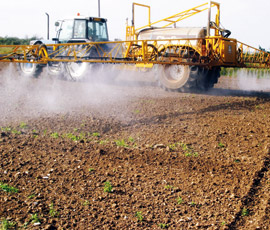Aphids still pose threat

A cold winter and late spring have cut the threat from disease-carrying aphids in cereal crops this autumn giving growers some respite, although high numbers in cereal volunteers show there is still a risk.
The dry summer has also limited aphid numbers, while fears of increased aphid resistance to widely used pyrethroid insecticides have not materialised, offering growers further relief.
Aphid species can pose a threat to cereal and oilseed rape crops by carrying diseases such as barley yellow dwarf virus (BYDV) and turnip yellows virus (TuYV), with the former causing up to 75% yield loss in barley and 30% in wheat.
Richard Harrington at Rothamsted Research says fortunately resistance levels in aphids have not increased.
“While it may be in some parts of the country that 50% or more of grain aphids have got resistance, it hasn’t shot up to 70-100%, which is where it looked as though it was heading,” he says.
Dr Harrington says BYDV-carrying aphid numbers in the East and South of England are below a 10-year average, while the latest findings show Herefordshire is a hotspot for the peach potato aphid, which carries the costly TuYV.
His colleague, Martin Williamson, has been closely involved with the resistance work carried out at Rothamsted and agrees this year could have been a lot worse.
He points to the Insecticide Resistance Action Group’s recommendations for growers dealing with any threat this year.
“The main recommendation is that if you are using a pyrethroid then use them at full strength because the mutation we have found doesn’t give strong resistance; it gives moderate resistance,” Mr Williamson says.
Meanwhile, Dr Harrington says although there has been aphid activity in crops, the low numbers in the summer have reduced the base for them to build upon.
“Most of the bird-cherry aphids that we are catching are the type that are going to bird cherry trees to lay eggs rather than the types that are going to be in cereals spreading BYDV,” he says.
In the North of England, Arable Group agronomist Julian Thirsk believes any issues of resistance should be a reminder to growers not to take the threat of aphids lightly this season.
“The weather is still relatively warm, so hopefully people will be much more vigilant and not complacent,” he says.
Many growers have opted to use a clothianidin-based seed dressing in their cereal crops giving them cover for at least six weeks after crop emergence, but Mr Thirsk warns growers to be be aware of the risk.
Mr Thirsk has decided to take no chances this year, with early-sown cereals set to receive two treatments and later-sown crops one, with the option of another if needed.
“As soon as they are getting two to three leaves we are going on with cypermethrin. If it stays warm then obviously there is still a chance of aphids migrating and the threat will remain,” he adds.
This should give protection for between 10-14 days if the weather stays mild, according to Mr Thirsk, who advises a further application Hallmark (lambda-cyhalothrin) if needed.
The threat of gout fly is also being monitored with Mr Thirsk saying although the pyrethroid will be effective, timing will be key with a narrow window of control.
Further south in Hampshire, independent agronomist Steve Cook has witnessed very little aphid activity but stresses he will stay alert until Christmas, with any spike of warm weather likely to prompting more aphid activity.
“It wasn’t a good summer for aphids because it was dry early on and we just haven’t seen that many,” he says.
Mr Cook says that most crops have been in the ground for two to three weeks, so for those with a seed treatment he will wait another three weeks before contemplating a further insecticide.
“On the crops that haven’t received a seed treatment, we’ve just put the first Hallmark spray on and we will spray again in 10 days’ time which may just be a simple cypermethrin,” he says.
He adds that a change to colder weather will limit aphid activity, but it could restart on any warm still days in November or December.
“In cases where the seed treatment runs out and the threat is still there, I will just go with one application of cypermethrin, which should take it through to the winter,” he says.

